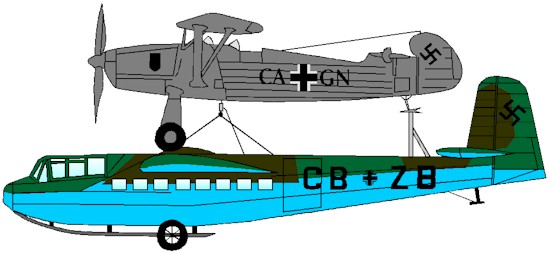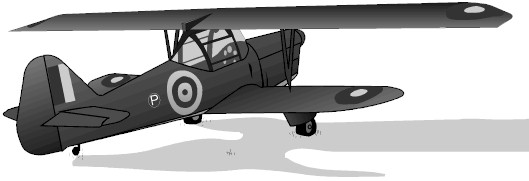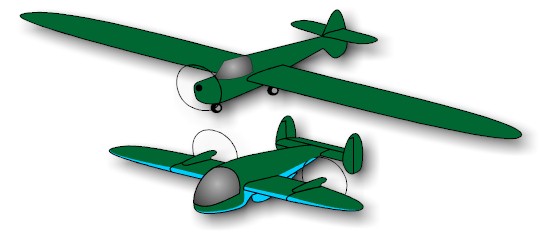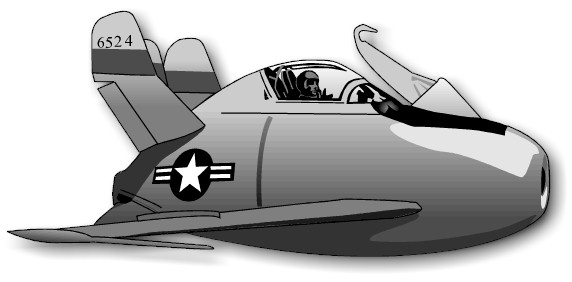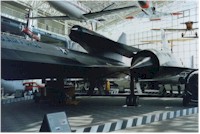| Vladimir
S Vakhistrov He is the pioneer (to my knowledge) of the parasite-concept. His first experiment dates from 1930. He launched a aerial target from a R-1 biplane. This test resulted in the idea to launch manned fighters in the air to make their range longer. The first test with manned fighters was done by placing two modified (removed lower wing from this biplane) I-4 fighters on top of the wing of a TB-1 (ANT-4). The modification of the biplanes was done because they feared that the lower wing would be in the turbulent air from the propeller of the "Aviamatka" (=mother aircraft). First flight of this combination was on 31 December 1931. The combination was called "Samolyot zveno" (= aircraft nest). Vakhistrov and all the pilots received a Red Star Order for this successful test. Further development of the system lead to a combination of 6 airplanes. The mother aircraft, two aircraft on top of the wing, two aircraft below the wing and one aircraft under the fuselage. This last aircraft hooked up when the rest was in the air. I hear you think: "Those combinations are pure circus acts, they have no operational potential." Well, you are wrong. The Russians used these combinations on 16 missions. The first attack was made on a refinery in Romania on 1 August 1941.
|
||||||||||||||||||||||||||||||||||||
|
||||||||||||||||||||||||||||||||||||
| USS
Acron & USS Macon I got this remark from Frédéric Grosshans: "I don't know if you consider airship-born planes as parasites. If you do, your parasite page is missing the only aerial aircraft carriers, the USS Akron and its sistership the USS Macon, built by the US Navy in 1931 and 1933. Each airship carried 5 "sparrow hawk" planes, which could take off and "land" from the ship during flight. You have more detailed information at http://www.ciderpresspottery.com/ZLA/greatzeps/american/Akron_Macon.html" Later I got the following links from Frédéric about the same item: "http://www.naval-airships.org/f9c.html . There is another picture of the sparrowhawk on http://www.lucidcafe.com/library/macon.html" I recall this project. When I find better pictures or more detailed pictures, I will use them to make some drawings. Short
Mayo Composite:
|
||||||||||||||||||||||||||||||||||||
|
||||||||||||||||||||||||||||||||||||
|
||||||||||||||||||||||||||||||||||||
DFS
230 combinations: I guess that the combination also had less influence to bad wind conditions due to the lack of a loose cable between both.
|
||||||||||||||||||||||||||||||||||||
|
||||||||||||||||||||||||||||||||||||
| Mistel: Siegfried Holzbauer, a test pilot of Junkers, made in 1941 a proposal to use a combination of a fighter and a unmanned, bomb filled older bomber to throw the bomber on large targets like bridges, boats, factories, bunkers and so. At that time there was no need for such a radical method, so the idea was dropped. But when, at the end of the war, the Germans became desperate the idea was reborn (due to the successful flights with the DFS 230 combinations). The official name was "Beethoven Gerät" or Beethoven Device. Most know it under the name "Mistel" or Mistletoe. As lower component they used a Junkers Ju 88. Messerschmidt Me 109s and Focke-Wulf Fw 190s were used as upper components. The Ju 88 got a special designed 380 pound warhead instead of the cockpit. At the second bomb bay 50 kg cement bombs were carried as ballast. The warhead could (at the used speed) penetrate 60 feet of reinforced concrete. Together that would give quite a bang. DFS (having experience with the DFS 230 combinations) designed the support between the two components. The extra drag made the speed drop to 235 mph. This made the Mistel a easy target for enemy fighters. Some operations were carried out. 4 attacked some boats, although all were direct hits, no ship sank. Several other operation were planned, but mostly dropped due to the continuously changing situation of territory. At the end most were used to destroy bridges to slow down the Allied and/or Russians. They think that there were about 250 Mistels made. At first older Ju 88 were used, at the end they used Ju 88s straight from the factory! To show the further development I quote a book named "Hitler's Luftwaffe" by Tony Woods and Bill Gunston (1977)(ISBN 0-86101-005-1):" In the closing weeks of the war other Mistel combinations included the Ju 88 G-7/Ta 152H, Ta 154/Fw 190, Ar 234/ Fi 103, Do 217K/ DFS 288 and for research Si 204/ Lippisch DM-1. There were many projects, such as the Ju 287/ Me 262 and Ar 234 C/ Arado E377 (small pilot less bomber) and the Führungsmashine (Ju 88H-4/ Fw 190 A-8) intended as a long-range pathfinder. The upper component in this case was purely an escort." I believe that the Do 217K/ DFS 288 was also for research. To make things a bit more clear I made a short description of the mentioned airplanes. Focke Wulf Ta 152: single engine aircraft (better
known as "the longnoised Fw 190) The Arado projects mentioned in the quote were quite interesting. I found a good description in "Arado 234 Blitz" (Monogram Monarch 1) by J. Richard Smith & Eddie J. Creek (1992) (ISBN 0-914144-51-0 (264p- many pictures and drawings- colours- hardcover- one of my most favorite owned books!). Due to the slowness of the Mistels using the Ju 88, they couldn't survive long in a hostile airspace. Arado suggested to use the Arado Ar 234, a multi jet-engine high-wing bomber or reconnaissance airplane, as a quicker base. A Mistel like proposal suggested a Ar 234/ Ar E377. The Arado Ar E377 was a unmanned mid-wing airplane which could have a 2000 kg (4409 lb) hollow-charge warhead or a 1800 kg (3968 lb) bomb mounted in the nose. Two version of this Ar E377 were suggested. A unpowered one and a version which had a jet-engine under each wing. Both combinations had the Ar E377 mounted on a takeoff trolley and the Ar 234 was mounted on top of the Ar E377. There was also a proposal to used a Heinkel 162 Volksjager with the powered Ar E377. No prototypes were made. The war probably ended too soon. Another interesting Arado project was to use the Arado 234 as a flying base for the Fieseler 103 (better known as the V-1). Three proposals for mounting the V-1 were made. One featured the use of a rigid tow bar behind the Ar 234. The second one mounted the V-1 on a takeoff trolley and the Ar 234 on top of it. The third had the V-1 mounted on top of the Ar 234. The last version made use of the conventional landing gear of the Ar 234. If you would think "Impossible", than I have to tell you that 4 tests were made using the first proposal. A unpowered V-1 was used during these tests. The fourth test ended in the destruction of the tow bar, due to the unstability of the concept. I guess that the other proposals would have had more success when tested. The last (known to me) parasite Arado proposal was the combination of a Ar 234 and a Ar E381. The Ar E381 was a small, rocket powered fighter. The reasoning was that the best way to protect a fighter was to place armor around the engine and the pilot. For conventional airplanes this would lead to a increase of weight that would reduce the performance a bit too much. The tiny Walter rocket engine could easily be protected using a small armored tube. Due to the ground clearance of the Ar 234 , the pilot of the Ar E381 (which was hung under the Ar 234) had to be proned. In this position a pilot could also easily be protected with a armored tube. The first design had one difficulty: once hung under the Ar 234; there was no possibility that the pilot could leave the Ar E381. A second proposal had a sideway entrance. The AR E381 had a single 30mm Mk 108 cannon and 45 rounds of ammunition. This would be good for two attacks. In "NATTER, Bachem Ba 349 und andere deutshe
Kleinstraketenjäger" by Joachim Dressel in "Waffenarsenal"-serie
(1989)(ISBN 3-7909-0361-2 (48p- many pictures and drawings- German text-
soft cover)) I
found a good description of how a mission with a Ar E381 would look like. First the
combination took off and climbed to 6000m. Once disconnected, the Ar E381 could climb very
fast (probably under a climb angle of 60° like a Messerschmidt Me 163) to the level of
the bombers. On that level it had a offensive range (= area to make attacks on bombers) of
30 km. After the attacks the pilot cut power, glided away from the bombers and used the
remaining fuel to look for a airstrip to land in a range of 120 km. Landings were made on
a skid. |
||||||||||||||||||||||||||||||||||||
I don't have the boxes myself, so I could use a JPG-file of the pictures as well. Please, no e-mails larger than 500 kB (or my mailbox will not receive them) and a maximum width of 550 pixels. Thanks on advance. |
||||||||||||||||||||||||||||||||||||
| Bi-Mono: Designers always wanted more wing area during take-off and less during flight. Such a proposal came in 1940. The origin of this idea dated from 1920, but I leave this origin research to historians. In 1940 W.R. Chown (Managing Director of F. Hills & Sons LTD, a manufacturer of light aircraft in Manchester, England) suggested to use a detachable wing during take-off. He had no official support, so he made the prototype using his own finances. A manned scale model was made in seven weeks. It was a small low-wing airplane with a detachable upper wing. Officials thought that throwing away the wing would cause problems, but the test made on 16 July 1941 proved that separation could be made without any problems. The upper wing gently glided to the sea and was lost (upper wing was designed as a expandable wing). The pilot of this test flight didn't even had to retrim his aircraft after separation. So stability was only not a problem. The project never received any registration or serial number. Officially is was only known as "Experimental Aeroplane N°133" in the wartime series. The nickname was "Bi-Mono" I know that this not a parasite, but I use the Bi-Mono as a introduction to the next design.
|
||||||||||||||||||||||||||||||||||||
|
||||||||||||||||||||||||||||||||||||
PB 37 Slipwing:
|
||||||||||||||||||||||||||||||||||||
|
||||||||||||||||||||||||||||||||||||
| Hills Hurricane: There was another Hills & Sons project with detachable wings. A Hurricane was outfitted with a upper wing filled with fuel. The wing had the same dimensions as the original Hurricane wing. Once empty the wing was detached and lost. They extended the range of the Hurricane this way. A small production of 40 was made. |
||||||||||||||||||||||||||||||||||||
| He 111 / Fi 103 ("V1"): |
||||||||||||||||||||||||||||||||||||
| McDonnell XF-85 Goblin: With the development of the XB-36 (unofficially named "Peacemaker") there came a large bomber, which had a loooong range and a heavy defensive armament. But they wanted more defensive for their huge B-36 fleet. They wanted fighter cover for their fleet. It seems like a perfect idea ... if they had fighters who could follow the bomber during their loooong missions. But their were no such fighters. Many thought about a possible solution. The solution could be found in the bomb bay of the huge bomber. The idea rose to make a tiny fighter that fits in the bomb bay and could be dropped whenever the bomber needed cover. Retrieval would be done by a advanced hook-up system. The requirements for this new fighter were:
|
||||||||||||||||||||||||||||||||||||
|
||||||||||||||||||||||||||||||||||||
| Only Mc Donnell
Aircraft Company (now McDonnell Douglas Corporation) entered a proposal. Their design, the
XF-85 Goblin, was at first a bit to large and to heavy, but was later approved. The
airplane looked like a engine nacelle with a pilot sitting on the engine. It soon had the
unofficial name "Bumble Bee" due to its fat, short shape. It had 6
tail surfaces
(3 on top, 3 below), no landing gear and a hook-up system in front of the pilot. The
combination was made on the ground. The aircraft was placed in a pit and then hooked up
and pulled up. Since there was no B-36 available to make the test, they transformed a B-29
to carry the hook-up system. Several flight tests were made. But some retrievals did not work as planned and did lead to belly landings. Luckily the design had a heavy plate for belly landings. In the book "YEAGER" by General Chuck Yeager & Leo Janos ( ISBN 0-09-947040-3 (paperback- 448 p- 21 pics)) Yeager (who flew chase on these test missions) says that the project was lost due to bad piloting of a civilian test pilot. "They couldn't fly in formation, they had no background or training". In the book "To Fly and Fight" (memoirs of a triple ace) by Col. Clarence E. "Bud" Anderson & Joseph P. Hamelin ( ISBN 0-553-29240-4 (paperback- 353p- some drawings of mentioned airplanes)) Anderson says that the Goblin was unstable. The project was cancelled after only two hours of test flying. Yeager says: "It was a shame to see a good program and good equipment ruined by bad piloting." You can see the Goblin, according to my resources ("Great aircraft collections of the world" by Bob Ogden (1991)(ISBN 1-85627-012-2 (hardcover- 200p- plenty pics)), in the Strategic Air Command Museum in Belleville, Nebraska. That is 16 km (10 miles) south of Omaha.
|
||||||||||||||||||||||||||||||||||||
|
||||||||||||||||||||||||||||||||||||
FICON
|
||||||||||||||||||||||||||||||||||||
| Vogt's
MX-1016: Dr. Richard Vogt, a German airplane designer know for his unusual designs (see asymmetric airplanes), was brought to America at the end of the war. He had a theory to use free floating panels to make the wingspan longer. The resulting extra lift would result in more range with the same fuel. This idea caught attention. Anderson was involved in this program. In his book (mentioned above) he writes a excellent part on this subject. The project was called MX-1016. The first test were made with a C-47, the military version of the twin-engine airliner DC-3, and a Culver Q-14, the military version of the Culver Cadet. The Q-14 is a small, light, single-engine,low-winged, prop-driven airplane. The tests were made with a simple coupling system of a ring on one side and a lance-and-ball on the other side. After some practice couplings were made in the air. The first were a bit troublesome, but after some practice Anderson could make a coupling in five to thirty seconds. Once coupled the ailerons were useless. They found out that lining up the airplanes could be done by using the elevators. Anderson found a easy reference to line up. He used the slip-skid indicator (better known as the "ball"). He once even pulled on his parka while he was coupled. The pilot of the C-47 saw this and thought to scare Anderson by wiggling his wings. Anderson kept his eye on the ball and nicely moved along with the wiggling wing. Many had doubts about the stability of this combination in bad wind conditions. Tests came sooner than expected. A invited photographer, sitting in a B-29, wanted to take some pictures from the front. The combination came into the prop-wash of the B-29. It became a hell of a ride, but all came out nicely. Stability was proven. The next phase in the tests were B-29 / F-84 combinations. Here they had new problems. The wing of the B-29 did flex more than the rigid wing of the C-47. The F-84 fighter had to stay in phase with the up and down movement of the wing. After 137 couplings, using the same ring and lance-and-ball coupling as the first tests, the wingtips were provided with the necessary coupling devices to gather data to test the theory of Vogt. The former couplings proved that the concept of coupling could be done, but the air has free play between the wingtips. Vogt's theory needed wind tight connections. The test made by coupling two fighters to the bomber with the new coupling device showed that Vogt's idea was somehow right. Due to the not so excellent wind tightness of the couplings there was no gain in range, but ... two fighters had a free ride. So things did look good for the moment. The first couplings and line-up were still done without the use of any electronic devise. But there was need for a autopilot to make things a bit easier for the fighter pilots. And here started the troubles. Electronics needs to be informed of the wanted reaction time and force. The pilots said to the technicians that they had to use the stick very gently, because some elevator deflection resulted into a heavy reaction in line-up. The first test with the autopilot went alright till the test pilot hit the button of the autopilot. The reaction of the autopilot was too hard. The fighter rotated around his wingtip. The explosive bolts, which worked when the angle between the fighter and bomber became too large, didn't had the time to react. All happened so fast. The fighter smashed into the bombers wing, destroying the bombers wing. The combination spiraled to earth. The crew of the bomber used during this flight a pressurized cabin. Normally the cabin was unpressurized, because in need it is hard to open the doors to jump. But the trust in the concept was so high that moment, that the crew used a pressurized cabin. All crew members (5+1) were lost. Anderson did lose a dear friend. To me, a amateur, the concept was not worthless. The accident was due to ONE bad instrument, not due to the concept. Many test projects of unusual designs ended this way. Pity, critics always give the concept the blame. The Bachem Natter, a German experimental VTOL fighter, ended the same fate due to a cockpit cover that was badly glued and came loose during take-off. Another good concept that was lost. |
||||||||||||||||||||||||||||||||||||
| Tom-Tom:
I was surprized when I found in my books another tip coupling parasite. It is a combination of a B-36 bomber with F-84 fighters. I thought: "Hey, F-84 fighters. I have seen these before as parasites." Did the airforce restart the theory of Vogt? Or did the writer of Andersons book mistype the name of the used bomber? I don't think it is a typing mistake, because the project is labeled as "Tom-Tom" and not as MX-1016. I didn't find a as lively written text about this project as I did of the MX-1016-project. My resource, Air Enthousiast november 1990 edition, just states that the first succesful tests were done in 1953 and that the idea was quickly shelved after a F-84 tore loose of the B-36 due to the up-and-down movement of the bombers wing. The site mentioned above (see FICON) also has a good page on this item. |
||||||||||||||||||||||||||||||||||||
| Space Shuttle:
I guess that most will have heard or maybe seen the next combination. It was a combination of a Space Shuttle (I think it was the Enterprise) and a Boeing 747 as mother airplane. They made a world wide tour to promote the Space Shuttle. I saw it over Brussels. It was a nice sight and it really caught attention.
|
||||||||||||||||||||||||||||||||||||
| SR-71
/ D-21: I also found a picture of a plastic model of parasites. But I found no proof that this combination really existed or was planned. It was a combination of a SR-71 Blackbird and a similar smaller airplane on top. I got the following remarks.
Donald Fritz did send me the following pictures. Thanks,
man !!!!!! |
||||||||||||||||||||||||||||||||||||
| Future of parasites? I have been thinking about these parasites. I did add a page named "Sea parasite". The idea is about the combination of parasites and commercial and/or transport amphibious airplanes and maybe giants too. Go see the page in the sector "Weird designs". I believe that parasites still have a future. Sure now that the coupling can be made "easier" with the use of automatic piloting systems. If they can make a F-117 fly, they can make this coupling!! |
||||||||||||||||||||||||||||||||||||


